by Todd Rutherford
As we move further into the fall season, many gardeners have turned their attention to cleaning up and preparing to put their gardens to bed for winter. Gardeners should also take this time to plan ahead for spring blooming bulbs which are currently available in your local garden center. Now is the perfect time to add these must-have jewels to your landscape. For most areas in Colorado, you should plant these bulbs sometime between the middle of September to the end of October. I have planted bulbs as late as November during a mild fall and winter. As long as the ground is not frozen, you can plant bulbs. However, by planting in early fall you give the bulbs time to establish some roots before the soil freezes, ensuring the best success. Lucky for us, the growing conditions in much of Colorado are perfect for spring blooming bulbs. The climate and ecological conditions of many of the bulb’s native ranges are quite similar to our high plains region.
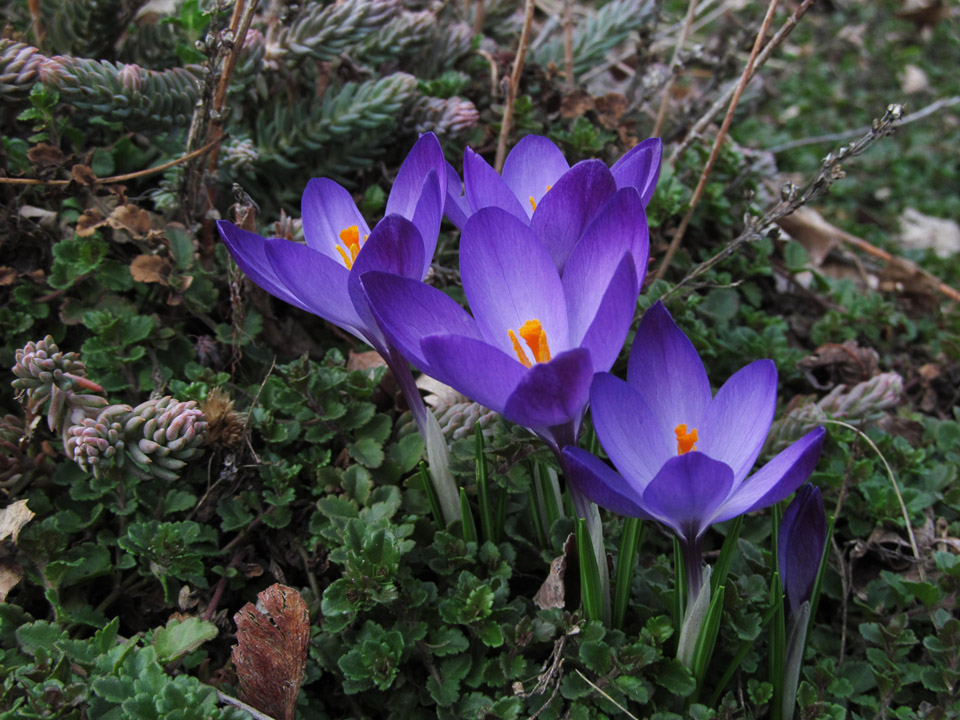
Crocus popping up through veronica and sedums.
The diversity of size, shape and color of spring blooming bulbs is fascinating. Some of the best bulbs to plant in our area are (listed in order of bloom time) :
Early Spring Bloomers: crocus, Siberian squill, snowdrops, dwarf iris, and species tulips
Mid-Spring Bloomers: hyacinths, daffodils, grape muscari, fritillaria and tulips
Late Spring Bloomers: alliums, irises and fox-tail lillies
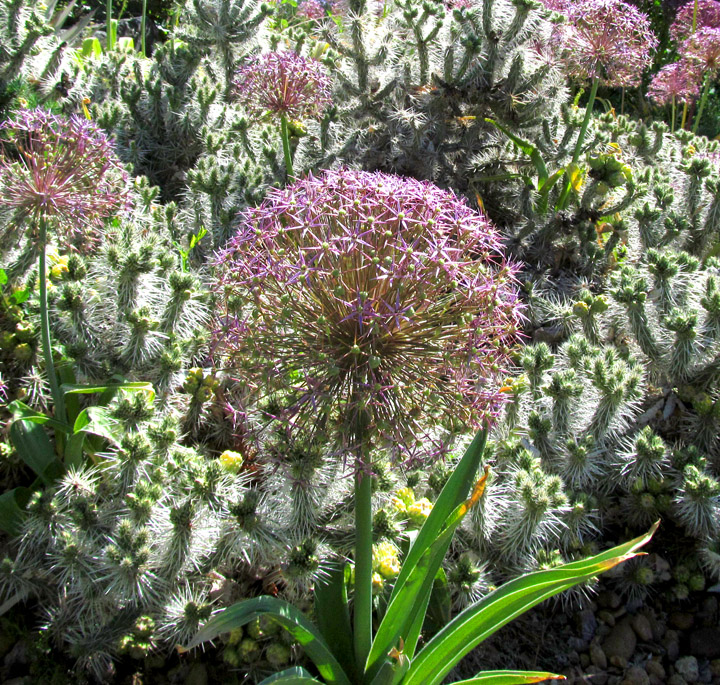
Alliums with Cholla cactus.
Fall planted bulbs do best in soils that are well drained. If the soil is too wet, the bulbs may rot. The rule of thumb is to plant the bulbs at a depth 3 to 4 times the length of the bulbs. If you buy bulbs in a package, a visual guide to bulb planting depth is usually printed on the package.
Consider adding “bulb food” to the holes you’ve dug before you drop in the bulbs. Phosphorus fertilizer will give your bulbs a boost, and help them become established. Traditionally a product called “bone meal” was recommended for providing phosphorus to bulbs. But research done at Colorado State University has shown that product doesn’t work well in our typically alkaline soil chemistry. Consider a conventional (a.k.a. “non-organic”) fertilizer called “triple super phosphate”. However, using phosphorus from conventional fertilizers has been linked to environmental damage such as toxic algae blooms in lakes and rivers. Use the conventional phosphorus sparingly and carefully. If you’ve not already done so, amending your soil with compost is also a good idea to improve soil texture for your bulbs.
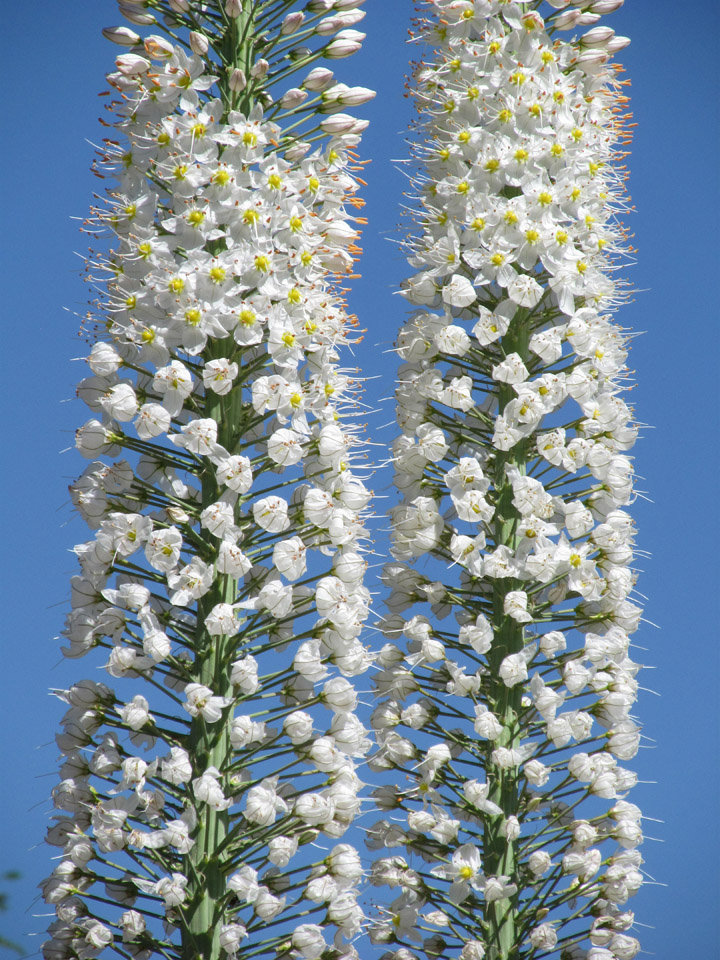
Close up of foxtail lillies.
Most spring blooming bulbs do best in full sun to part sun locations as opposed to deep shade. But if the site is south facing in full sun, that area’s soil may warm up too much in late winter, causing the bulbs to flower early and those blooms would be susceptible to frost damage during cold snaps. It is a good idea to mulch the soil where you’ve planted the bulbs. Mulch will keep the soil from drying out, and help moderate soil temperature so it doesn’t warm up too quickly.
Design-wise, you can tuck just a few bulbs into niches between established perennials and ornamental grasses in your garden, or you could add large groupings of one type of bulb to get maximum color punch in your landscape. One effective way to add bulbs to an existing garden is to place them around low-growing plants that will still be dormant when the spring bulbs emerge. That approach is particularly effective with low growing groundcover perennials. Some people will add early spring bulbs such as crocus or snowdrops to a lawn area, knowing that the grass won’t start growing or need a mowing until after the bulbs are done. And if you want to add bulbs year after year, you might want to make a plan or take photos of where the existing bulbs are when they are blooming. That way you can avoid disturbing the established bulbs next time you add more in the fall.
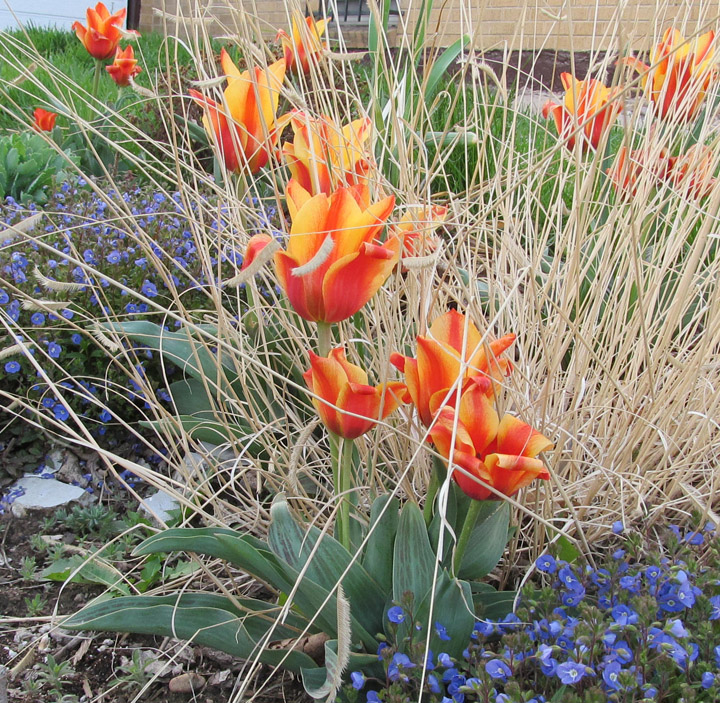
Tulips mingling with veronica and the remnants of last year’s ornamental grass.
For all the bulbs, you should not remove the leaves after the flowers have faded, until the leaves have turned from green to brown. Removing green leaves too early deprives the bulbs the ability to feed themselves in preparation for the next year’s blooms.
If your bulbs are “happy” where you’ve placed them, there’s a chance they will supply you with gorgeous blooms for many years. Adding spring blooming bulbs to your garden is an easy way to get dependable spots of color into your landscape for a springtime show!
This is the official blog of Outdoor Design Group, Colorado Landscape Architects. For more information about our business and our services, click here.
Related Posts:
by Matt Corrion
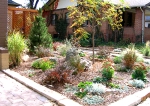 Fall. When the morning air turns crisp and cool and the leaves begin to float softly to the ground. Not only is it my favorite season, there are many maintenance tasks to be accomplished in the landscape. The info below includes tips on what I have found are the most important and useful tasks- so get out there, have fun with it, and enjoy the autumn weather!
Fall. When the morning air turns crisp and cool and the leaves begin to float softly to the ground. Not only is it my favorite season, there are many maintenance tasks to be accomplished in the landscape. The info below includes tips on what I have found are the most important and useful tasks- so get out there, have fun with it, and enjoy the autumn weather!
Key Dates
- Early October: It is a good idea to winterize your irrigation system and blow out the lines. Many landscape maintenance companies will provide this service for less than $50, or it is pretty simple to do it yourself.
- October 15th: Don’t plant any grasses or perennials after this date. Many of them won’t survive, and you will have much better luck in the spring.
- November 1st: Don’t plant any evergreens (especially trees) after this date. Some deciduous trees and large deciduous shrubs can be planted later if they are balled and burlapped (B&B), but I would recommend waiting until spring when you’ll have much better success.
Trees and Shrubs
- Prune trees and shrubs to remove dead branches or to control their size. Fall is the best time to do this for the health of the plants. Consider consulting with an arborist before any major pruning on trees, or at least do a little research on techniques. When pruning shrubs, always try to maintain the natural size and growth habit of the species- Avoid over-pruning or sculpting unnatural shapes, unless you are creating a specific look such as a hedge. Instead of using power shears to lap off shrubs on a straight line, consider using hand pruners to thin the interior branches to maintain a healthier more natural look.
- Remember to check soil moisture, and water if needed. Even though you may have your irrigation system shut down for the year, fall often brings some warm, windy days that can really dry things out. Pay special attention to anything that was just planted this year.
- Make sure you have plenty of mulch around trees and shrubs- this helps maintain moisture and keeps the soil from drying out over the winter.
Perennials and Ornamental Grasses
- Prepare tender and semi-hardy perennials and shrubs for the upcoming cold winter. I like to let a few of the fallen leaves that tend to build up around the bases of these plants remain there for the winter- they will provide insulation around the base of the plant from the cold. This also saves you some leaf cleanup now that you can do in the early spring. If necessary, place additional wood mulch around the base of these plants for more insulation- pay particular attention to areas with northern exposure.
- Leave spent stems and seed heads on grasses and perennials until spring, to enjoy their winter beauty and to provide cover for birds and wildlife. Or, if you must have a neater look you can cut them back now, to a height of about 6-8″ off of the ground.
- Dividing: Some plants can be divided in the fall and replanted in other areas. Other species don’t like the fall division/planting though, and I think that spring is a much better time to do it. If you decide to divide, remember to water the plants well for a couple of weeks.
Lawns
- Rake those leaves! If left on the lawn they can smother it and cause issues such as mold and fungus.
- Consider aerating your lawn. Aeration allows greater movement of water, fertilizer, and air which stimulates healthy turf. Aerating also increases the speed of decomposition of the grass clippings and enhances deep root growth. Compacted soil especially benefits from core aerating.
- You may want to fertilize your lawn or use a “weed and feed” type light pre-emergent herbicide in the fall for maximum growth the following spring. Don’t over do it though, because fertilizer and herbicide can wash off of your lawn and the runoff can be harmful to water supplies and wildlife.
- Assess the size and configuration of your lawn, and how much water you used this year to keep it green (or, brown?). Consult with a landscape architect about how you can redesign your landscape to make it more attractive, sustainable, and functional.
Fall Weather Considerations
- The days are getting shorter and the weather is getting cooler. Keep an eye on the amount of precipitation we are getting- Fall can have extremes of hot and cold, dry and wet. Be observant. If you have heavy rain for a couple of days then turn off the sprinklers for a week or so to compensate. And if you have several days of warm, sunny weather then your landscape will certainly appreciate an extra drink.
Other
- Disconnect and drain hoses, but keep a hose handy for winter watering. I also like to wrap insulation or put insulated covers over the exterior faucets as an added protection from freeze damage (I once had a pipe freeze and break UNDER my porch, and had to take apart the porch to fix it!).
- Collecting seed: Stop deadheading late in the year and allow the seedheads to dry on the plant. Then you can collect the dried seeds to plant next spring. Store them in a cool, dark place in a container that does NOT have an airtight seal, such as an envelope (it’s also a good idea to label the container so you remember what plant it is next spring). Another option- leave the seeds on the plants and some perennials will re-seed themselves naturally.
- Start planning your spring bulb garden now. Spring-blooming bulbs are planted in the fall to provide the chilling time required for spring blooms. Remember to prepare the soil and plant bulbs at the appropriate depth listed on the package for the species.
- Start planning for design changes to your landscape for next year. Fall and winter are the best times to get your plans in order, and spring is the best time to install the changes- so get ready early for next spring, because it will be here before you know it!
- Take a break and toss the football around. Afterward, enjoy some warm apple cider with cinnamon. Finally, rake your leaves into a giant pile and take turns jumping into them with the neighbor kids!
This is the official blog of Outdoor Design Group, Colorado Landscape Architects. For more information about our business and our services, click here.
Related Posts:





 Fall. When the morning air turns crisp and cool and the leaves begin to float softly to the ground. Not only is it my favorite season, there are many maintenance tasks to be accomplished in the landscape. The info below includes tips on what I have found are the most important and useful tasks- so get out there, have fun with it, and enjoy the autumn weather!
Fall. When the morning air turns crisp and cool and the leaves begin to float softly to the ground. Not only is it my favorite season, there are many maintenance tasks to be accomplished in the landscape. The info below includes tips on what I have found are the most important and useful tasks- so get out there, have fun with it, and enjoy the autumn weather!